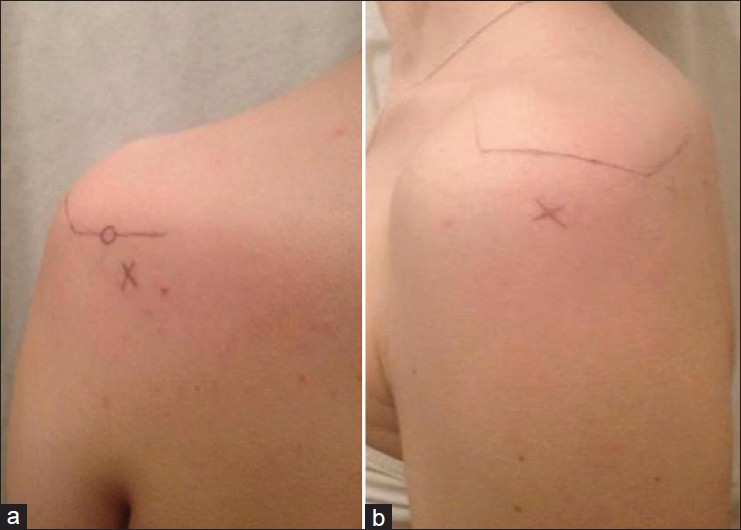|
| Article Access Statistics | | | Viewed | 1288 | | | Printed | 52 | | | Emailed | 0 | | | PDF Downloaded | 4 | | | Comments | [Add] | | |
|


Click on image for details.
|
|
| |


 |
| Year : 2012 | Volume
: 6
| Issue : 4 | Page : 136-137 |
|
|
|
|
|
LETTER TO THE EDITOR Subacromial corticosteroid injection using the posterior or lateral shoulder portals
Neil R Wickramasinghe, Nicholas D Clement, Daniel E Porter
Department of Orthopaedics and Trauma, The Royal Infirmary of Edinburgh, Little France, Edinburgh, EH16 4SA, United Kingdom
Correspondence Address:
Neil R Wickramasinghe
47 Heronway, Hutton Mount, Brentwood, Essex, CM132 LQ
United Kingdom
 Source of Support: None, Conflict of Interest: None
DOI: 10.4103/0973-6042.106229

|
|
|
|
| Date of Web Publication | 18-Jan-2013 |
How to cite this article:
Wickramasinghe NR, Clement ND, Porter DE. Subacromial corticosteroid injection using the posterior or lateral shoulder portals. Int J Shoulder Surg 2012;6:136-7 |
Sir,
Shoulder pain is a common symptom which afflicts 11.7% of the UK population, [1] and accounts for a significant proportion of the musculoskeletal problems in general practice. Subacromial corticosteroid injection is an effective management option in several shoulder pathologies, which cause shoulder pain; and an optimal technique is needed to achieve patient satisfaction. When performing a subacromial corticosteroid injection, the subacromial space can be accessed via posterior or lateral approaches. Our work utilizes two-point discrimination to evaluate sensation at the posterior and lateral shoulder portals; with the aim to compare innervation density at these sites. If innervation density varies between the injection sites, conscious injection of the shoulder at these different portals may stimulate differing degrees of pain. This may directly affect management outcome and patient satisfaction, and therefore should be considered when deciding which shoulder portal to utilize.
Twenty-nine healthy volunteers were recruited; 22 male and 7 female, with a mean age of 22 years (18-23). Using two-point discrimination, sensation was assessed at the posterior and lateral shoulder portals, while the subject was blindfolded. The posterior shoulder portal was defined as 1 cm medial and inferior to the posterior corner of the acromion; and the lateral shoulder portal was defined as 2 cm distal to the mid-point of the acromion on the lateral aspect [Figure 1]. These two regions were tested on each shoulder, and two measurements were taken at each location, and an average minimum separation at each location was calculated. Two-point discrimination data were normally distributed, and paired t-tests were used to compare posterior and lateral sites. The significance level was set at P ≤ 0.05. | Figure 1: (a) External view of left shoulder showing the location of the posterior shoulder portal (b) External view of left shoulder showing the location of the lateral shoulder portal
Click here to view |
In all, 84% ( n = 49/58) of shoulders had a lower average two-point discrimination value (i.e., a greater discriminatory ability) at the lateral portal. The difference in two-point discrimination between lateral and posterior shoulder portals was significant (mean difference 6.6 mm, 95% CI 5.0-8.2, P < 0.0001).
As sensory discriminatory ability was greater around the lateral portal, the innervation density must be increased in this area. [2] Translated into a clinical setting, this data means that an injection using the lateral shoulder portal would potentially be more painful than an injection using the posterior portal. There is a clear relationship between a patient's experience of pain and increasing dissatisfaction with healthcare interventions; [3] patients receiving a lateral shoulder portal injection are therefore more likely to be dissatisfied with their management. As such it seems that pain severity should be considered when choosing the most appropriate site for subacromial corticosteroid injection.
Future research is needed to ascertain whether our results are clinically translatable. This could be a randomized controlled trial (RCT), where patients are given subacromial injections of corticosteroids either via posterior or lateral portal, and asked to rate the procedural associated pain via a visual analog scale, and rate the satisfaction with the healthcare they received. Utilizing our results, the hypothesis of the RCT will be that posterior injection will be less painful than lateral injection, and therefore patients will be more satisfied with posterior injection.
 References References | |  |
| 1. | Badcock LJ, Lewis M, Hay EM, McCarney R, Croft PR. Chronic shoulder pain in the community: A syndrome of disability or distress? Ann Rheum Dis 2002;61:128-31. 
[PUBMED] |
| 2. | Dellon AL. The moving two-point discrimination test: Clinical evaluation of the quickly adapting fiber/receptor system. J Hand Surg Am 1978;3:474-81. 
[PUBMED] |
| 3. | Jamison RN, Ross MJ, Hoopman P, Griffin F, Levy J, Daly M, et al. Assessment of postoperative pain management: Patient satisfaction and perceived helpfulness. Clin J Pain 1997;13:229-36. 
[PUBMED] |
[Figure 1]
|
|
